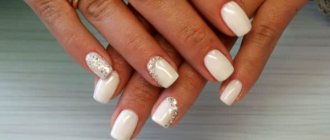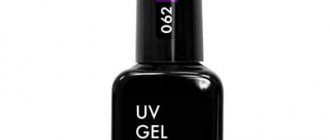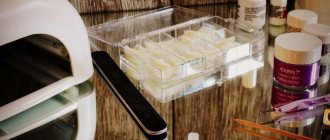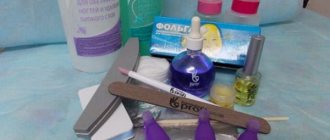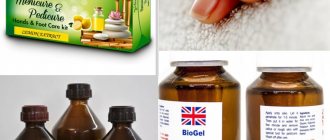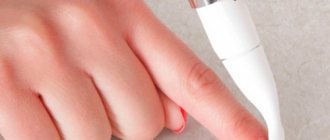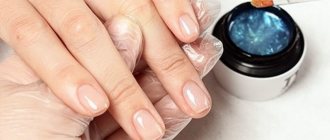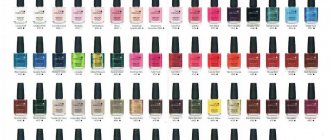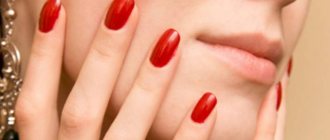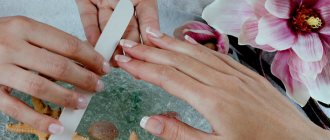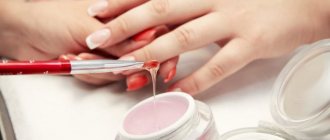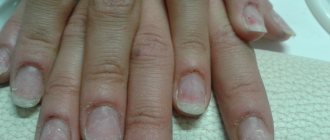From this article you will learn:
- What is the difference between biogel and gel polish?
- Which type of biogel is better to choose?
- How to properly strengthen and extend nails with biogel
- Is it possible to combine biogel with gel polish?
A neat and beautiful manicure is a must-have attribute of a modern well-groomed woman. But, unfortunately, not every representative of the fair half of humanity can boast of a successful shape and good condition of natural nails. In such cases, nail extensions with biogel may be a way out of the situation. Our article will tell you what this coating is, what types of it exist, and we will also talk about the intricacies of working with this material.
How does biogel differ from gel polish?
Gel polish has been popular among modern representatives of the fair sex for several years now. The main feature for which it is so loved is that it can hold on and maintain its attractive appearance for up to four weeks. This is an undeniable advantage over classic varnish coatings. To compare regular gel polish and biogel, you must first understand what these two types of material are and why each of them is needed.
Gel polish is a unique hybrid compound that combines the best qualities of ordinary polish and modeling gel. This coating hardens only under the influence of an ultraviolet lamp for a certain period of time.
But the main distinguishing feature of gel polish is not the specifics of its application. This material helps strengthen the nail plate, making it thicker, making both the manicure and the nails themselves more resistant to mechanical damage.
Biogel is a type of gel coating. Its main active ingredients are usually African teak wood resin, naturally occurring proteins, vitamins A and E and calcium. Their main purpose is to protect, nourish and strengthen the nail plate, as well as even out the color and improve the appearance of the cuticle. This coating does not contain chemically aggressive substances, and it is more elastic compared to gel polish.
Nail extensions with biogel (even at home) will not only not spoil the structure of your nail plate, but, on the contrary, will further strengthen it and protect it from harmful environmental influences. This is an ideal solution for the fair sex who have brittle and peeling nails. The healing characteristics are not the only positive property of this material. It can also be used as a decorative coating or as a base for manicure.
The difference between biogel and gel polish lies in their texture and principle of action.
The main distinguishing features can be identified:
- The biogel is dried both using an ultraviolet lamp and naturally.
- The use of gel polish requires additional correction.
- Manicure with biogel looks more natural.
- The undeniable advantage of biogel is its natural composition, which does not irritate or damage the nail plate. In addition, it is hypoallergenic and approved for use by pregnant and lactating women.
- Gel polish, when applied to the nail plate, fills all its cracks and chips. Biogel is similar in composition to a nail, so the connection with it occurs at the molecular level.
- Gel polish is susceptible to shocks and temperature changes, and under biogel the nail plates become more elastic and less brittle.
- Nails extended with gel polish require modeling and filing. Filing is accompanied by the formation of dust, which both the master and the client have to breathe. Working with biogel does not involve such a procedure.
- Gel polish allows you to make extensions of any length, and biogel nail extensions increase them by only 1-2 mm.
- The gel is removed by filing, and this is a rather long and labor-intensive process that injures the natural nail. The biogel coating is removed with a special liquid by soaking for 10–15 minutes.
The only disadvantage of using it is the price of biogel nail extensions. It is significantly higher than for a manicure with classic varnishes. It is worth noting that saving on your health is not always profitable, which is why, if possible, consider using this particular type of coating as the most priority and useful option.
Each woman decides for herself which material to choose. Both types of coating have their positive and negative sides. Strengthening the nail plate will occur in both cases. However, recently there are more and more rave reviews about biogel nail extensions.
Read material on the topic: Manicure ideas - bright, fresh, fashionable
Application and removal
Although the manufacturers of both of these compositions claim an equal period of wearing the coating, nevertheless, judging by the reviews, the biogel stays on the nails better. Its wearing period is on average 1 week longer than that of shellac, although material manufacturers promise that both of them will last up to 4 weeks. However, shellac begins to peel off faster and chip off the free edge.
The biogel adheres so firmly to the nail that the likelihood of the coating separating from the plate is extremely low. You can remove it from the plate only by dissolving it with a special compound. In addition, under biogel the likelihood of mechanical nail separation is reduced.
Having tried to remove shellac and gel polish, you will understand that the difference between these processes is minimal, especially if you have a specialized product for this. However, if you don’t have such a product at hand and you don’t plan to buy it, choose biogel. It can be removed quite easily using acetone-containing nail polish remover. Of course, shellac can also be removed this way. However, a much longer exposure time will be required and as a result the nails will suffer more.
https://youtu.be/StLw7EE6VDQ
?list=PLZQ84SRBSF5pgjRg1dtaIOD-AmvIH1nqC
[yandex2] [google2]
Manicure with biogel and gel polish
Many women are interested in the question of whether it is possible to use these two coatings at the same time. We can definitely say yes. But only if the biogel acts as a base, and the gel polish as a decorative coating.
The main advantage of such a manicure is that the nail plate will be protected from the harmful effects of gel polish, while the possibility of creating a wide variety of designs remains. Gel polish has a wide palette of colors and interacts well with different materials for decoration: rhinestones, beads, powder, dried flowers, stickers, etc.
Performing such a manicure is possible subject to the following recommendations:
- Biogel is used as a base and supports the nail plate.
- Before starting the procedure, get your nails in order: cut, polish, clean and degrease using special cleansers.
- Apply primer.
- Apply a layer of biogel and dry under the lamp for two minutes.
- Lastly, apply gel polish and also dry under ultraviolet light.
This combination is suitable for women who cannot imagine themselves without a bright and beautiful manicure. Unfortunately, biogel is rarely available in color, and is essentially transparent.
Recommended articles on the topic:
- Medical hardware pedicure
- Curvature of the nail plate
- Removing an ingrown toenail and how to avoid it
Comparative characteristics
| Gel | Biogel | |
| The main task | Creation of artificial nail covering of any length and shape | Strengthening natural marigolds, protecting them |
| Polymerization | 2-3 minutes in UV/LED lamp | 2-3 minutes in UV lamp |
| Layer thickness | Up to 5 mm | Up to 2 mm |
| Frozen structure | Solid | Flexible, quite elastic (similar to a natural nail) |
| Durability level | Lasting | Moderately durable |
| Time taken to apply the composition | 1.5-2 hours | 30-40 minutes |
| Weak spots | Fragility | Does not withstand exposure to household chemicals |
| Possibility of correction | Yes | No |
| How to remove? | By mechanical cutting (with the exception of gels with a soak-off formula - they are removed using a special liquid) | By soaking in an acetone-containing composition (the coating is removed within 10-15 minutes) |
| Wearing period | Up to 3 weeks | 2-3 weeks |
Types of biogel
There are three main groups of biogel coating:
- Sculptural. Used for extensions and decoration. It contains silk extract, which strengthens and nourishes the nail plate. It becomes more elastic and durable. This biogel has an opaque, natural color.
- RoyalSealer is a finishing or, as it is also called, top coat that whitens the nail plate and also eliminates its yellowness and grayness due to its bluish tint. Adds shine and shine to manicure. It can be transparent or multi-colored. It is often applied over a French jacket.
- S-Biogel is an independent composition. Its use does not require the use of additional fixatives. This type, like the previous ones, helps strengthen the nail plate and is suitable for extensions. Sometimes available in a specific color palette.
TheDifference.ru determined that the difference between biogel and gel is as follows:
- Gel is used for nail extension, biogel is mainly used for strengthening and protection.
- When frozen, the biogel resembles silicone, and the gel is hard, like durable plastic or glass.
- Gel-extended nails are fragile and can break or peel; after applying the biogel, the nail plate remains flexible, soft, and elastic. But biogel reacts poorly to household chemicals containing acetone.
- After applying the gel, the nails need modeling and correction; in the case of biogel, this is not required.
- Biogel is removed with a solvent; the gel must be cut off from the nail.
Nail extension with biogel
Biogel nail extensions can be done at home. You just need to purchase the necessary tools and supplies from a specialized salon. The standard kit for self-extension includes:
- Ultraviolet lamp.
- Biogel.
- Degreasing agent.
- Primer.
- Gel finish for the final stage.
- Files with abrasiveness 100–180 and buff 240–500.
- Orange sticks for processing and pushing back cuticles.
- Forms for extensions. They are made of paper, metal or Teflon. Preference should be given to paper options, as they are more convenient to use and are disposable, so they do not require disinfection after each use.
- Synthetic brushes with bristles No. 6 and No. 7.
Step-by-step instructions for nail extensions with biogel:
- Treat the surface of the nail plate with a degreasing agent. Remove cuticles with nail clippers. Treat the skin with a special liquid or remove it with an orange stick.
- Use a file to give your nails the desired shape. The choice of shape and length depends on the structure of the fingers, their thickness, as well as on the lifestyle and nature of your work activity.
- Use a polishing file to smooth the surface of the nail plate. Don't be afraid that this may somehow negatively affect the condition of your nails. Sanding removes shine and provides better adhesion of the coating to the plate. Use a brush to brush off the dust and treat your nails with a degreaser a second time.
- Install tips for nail extensions with biogel.
- Apply a very thin layer of bio-coating with a brush. The layer should not exceed 3 mm. Then dry under the lamp for 2 minutes.
- In total, you need to apply from three to six layers, based on how much thickness you need. The form can be removed after the first drying.
- Then the finishing layer (matte or glossy) is applied and polymerized in a lamp for 2-3 minutes. It is possible to make the last layer with ordinary transparent varnish, which is simply dried in air.
- Remove stickiness with a degreaser.
- Use a file to correct uneven shapes.
- Apply a special oil or moisturizer to your hands and cuticles.
It is necessary to remove the biogel coating after 2-3 weeks, since during this time the nail will grow back. To remove the material, you need to apply a special liquid to the surface of the nail with a cotton pad, leave it for a while, and then remove it with an orange stick.
Read the material on the topic: How to strengthen peeling nails
Nail gel: features of artificial coating
The so-called “hard gel” is a polymer synthetic material used for nail extensions. When exposed to ultraviolet light, it hardens to a glass-like appearance. Using a high-quality gel, you can create an artificial coating of any length. “Hard gel” has an increased strength index.
After application, the nail gel must be dried under a UV lamp. During the process of thermal exposure, the composition physically connects with the nail plate, filling all small voids, cracks and other imperfections of the nail surface. The gel, frozen in a certain form, certainly has strength and has an aesthetic appearance, but its high hardness index plays a cruel joke on it: the gel coating is significantly susceptible to chips, cracks, and any mechanical damage. But its main drawback is sensitivity to temperature changes.
After completing the modeling of the artificial nail using gel, the coating must be processed using the sawdust method. Although the dust generated during the modeling process is a small price to pay for the opportunity to create nails of the desired shape and length (and absolutely any).
How long does gel last on nails?
If the gel nail extension procedure is carried out correctly, the created coating will last for about 3 weeks. After this, it is necessary to correct the manicure. The gel composition that polymerizes on the nail plate is removed or modeled by mechanical grinding.
When should you choose nail gel?
This option is suitable for those who are not particularly worried about the condition of their natural nails, but want to look fashionable and become the owner of long nails of absolutely any shape (even to suit their mood).
Due to its special structure, the gel coating has a long “life” and rarely causes an allergic reaction. But at the same time, after wearing such material, natural nails require intensive treatment: restoration of the natural strength of the plate, its structure, etc. (this period, as a rule, is 2-3 months).
French using biogel
Nail extensions with biogel at home with a French design are also possible. To do this, you need to add a biological coating to all the necessary materials:
- camouflage pink;
- white.
Procedure:
- Sand and degrease the surface of your nails.
- If you want to increase the length, use forms.
- Using a medium-width flat brush, apply the first coat. Dry for one minute.
- Remove tips, if used, adjust the shape of the nails, degrease.
- Apply pink coating. It serves as the basis for the jacket. Dry under the lamp for two minutes.
- Using a white coating, paint stripes along the edge, holding the brush straight perpendicular to the nail. Align the arc line. Dry for one minute.
- Paint the smile line with white again to make it brighter. Dry for two minutes.
- Apply a glossy finish to give your manicure a fresh look. Dry in a lamp for one or two minutes and remove the sticky layer using a degreaser.
Having done similar nail extensions with biogel on forms (upper or lower), it is recommended to do housework (washing dishes, cleaning) wearing protective gloves. Despite the fact that this coating is durable and the manicure with it lasts for a long time, contact with chemicals and prolonged exposure to water should be avoided. The biogel will become soft and the extension result will deteriorate.
Nowadays, you no longer have to spend a lot of time performing complex and unpleasant procedures at home. It is much easier to seek help from real professionals - the Veronika Herba beauty and health center, equipped with effective and modern equipment.
Why clients choose Veronika Herba Beauty and Health Center:
- This is a beauty center where you can take care of yourself at a reasonable cost, while your face and/or body will be treated not by an ordinary cosmetologist, but by one of the best dermatologists in Moscow. This is a completely different, higher level of service!
- You can receive qualified help at any time convenient for you. The beauty center is open from 9:00 to 21:00, seven days a week. The main thing is to agree with your doctor in advance on the date and time of your appointment.
Sign up for a consultation with a specialist by phone +7 (495) 085-15-13
, and you will see for yourself!
What is better for strengthening nails: comparison of polygel and biogel
When choosing between poly- and biogel, you should rely on the goals that the client faces. For weak plates that have been thinned by regular extensions, the therapeutic effect is primarily important, not aesthetics and length, so it is advisable to use a bio-composition. Compared to biogel, acrylic still remains a completely artificial material, without ingredients that are beneficial to the natural plate.
And if the main task is to create an ideal durable coating on the nail, which will allow you to maintain the chosen design for a long time and grow in length, then polygel should be the clear choice. The durability of the coating is also of great importance - acrylic is able to protect the nail well from external influences and will hold up much better than biogel.
Everything described above makes it clear that there is no clear answer as to what is better for strengthening nails (biogel or polygel), the choice should be made in each individual case based on the condition of the nail plates and the desired result of the procedure.
Variety of gel
In beauty salons, there are three main types of gel with different functional loads.
- A gel of transparent consistency is used as the main base layer, since it does not have a bright color. The gel coating masks microcracks on the nails and smoothes the surface.
- Gel sculptor. It contains particles of silk, which give strength to the nail plate.
- Colored biogel. Nail art masters use it to create an original design, covering the nail in stages in two layers. With this manicure, brittleness of the nail plate is eliminated.
Do not neglect manicure , because it is the beauty and health of your hands. Contact first-class specialists in the beauty salon to get high-quality gel nail coating .
Step-by-step instructions for strengthening nails
Persistence does not depend on the day of the menstrual cycle, pregnancy and other myths. Treatment of nails with biogel can be performed for absolutely any condition of the plate; there is no need to grow the length or shorten it. The main thing is to prepare all the necessary materials and equipment in advance.
Required materials and tools
Polymer materials require drying in a lamp. Suitable for UV and LED. As for power, it is advisable to use at least 36 W. Otherwise, the material will polymerize slowly, the process may be delayed, or the gel will not harden at all. We coordinate the drying time with the information on the biogel packaging. On average, the process takes from one to two minutes. In LED lamps with a power of 48 W or more, 30-40 seconds are often enough.
Lamps for manicure, pedicure: types, features, popular brands
Choosing a hybrid lamp for manicure and our rating
What you need for work:
- biogel, brands RuNail, TNL, IRISK, EL CORAZON have proven themselves well;
- buff for polishing;
- degreaser, TNL brand is suitable, you can take Bluesky or any other manufacturer;
- file;
- primer, Bluesky and other brands listed above are suitable;
- aniseptic, you can take regular Miramistin;
- cuticle oil from any manufacturer;
- brush;
- napkins;
- top, it is advisable to take the manufacturer that is used for the main coating.
Since biogel is a soluble material, you need to use the same top coat so that you don’t have to cut off the top layers and then soak the base when changing manicures.
Preliminary preparation
Like any other durable coating, therapeutic biogel for nails requires a prepared surface. Otherwise, it will not hold on, and the manicure itself will not please you with a neat appearance. Under no circumstances do we soften the cuticle in water; we work on a dry surface or use special softening agents.
How to properly prepare your nails:
- We remove the old coating, if present.
- Push back the cuticle with an orange stick. If necessary, trim with tweezers.
- We separate the pterygium, clean the side ridges from crusts and dirt.
- We shape the free edge, file it, shorten the length if necessary.
- Wash your hands with soap and wipe dry. We do not use any cream before strengthening.
You can do the preparation with a device, it quickly and easily removes the pterygium, saves time, here it is important to take into account the condition of the natural plate and your own experience.
Strengthening
At each stage, it is important to pay attention to the cleanliness of tools and materials; you cannot check the quality of drying with your fingers, since they contain natural fat. The preliminary preparation of the plate, which is described above, should not be neglected.
How to strengthen nails with biogel:
- Treat your hands with an antiseptic. Miramistin or its cheap analogue Chlorhexidine is usually used.
- Buff all nails. There is no need to file down anything, we just remove the shiny layer from the plate. We pay attention to the areas and ends adjacent to the cuticle.
- We wet a napkin in a degreaser and wipe the nails. We are working with one hand for now.
- We lubricate the tips of the nails with primer; this product is often not used.
- Sometimes biogel for nails is used with a base, but this is not necessary. Take a brush, pick up some polymer, and apply a thin layer onto a fat-free plate. We seal the end.
- Place your hand in the lamp and dry it for 40 seconds to two minutes.
- Apply a second layer and dry again. Repeat as desired until you get the desired thickness. Or after two layers we apply a color coating and make a design.
- We complete the strengthening with a top. Dry for 2-3 minutes. Wet a napkin in a degreasing agent and remove the sticky layer.
- All that remains is to lubricate the cuticle with oil, which will moisturize the skin around the nail, give it a well-groomed appearance, and emphasize the neatness of the manicure.
Layers should be applied thinly and each layer should be thoroughly dried. If you apply it thickly, the material will not be able to harden even in 4-5 minutes, it will become rubbery, and small pits will appear when pressed.
Features of biogel coating
This option is ideal for girls who prefer long nails. The main characteristics that make it more popular than decorative varnish:
- Great for extensions, creating French manicures, and leveling the nail plate;
- features a large number of natural beneficial components, including keratin, calcium and teak resin;
- combined with vitamin serums, which are applied before extensions;
- perfectly gives the desired shape, promotes rapid growth.
This is a more gentle type of extension that preserves the health of the nails. According to client reviews, the plate under the biogel does not darken, evens out and grows back well. This is how it differs from the usual all-chemical compositions for extensions. Experienced specialists make a beautiful non-standard manicure, practicing the method of applying shellac to biogel. Such strengthening can be done over a fairly long period of time.
